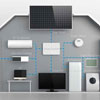
Wireless for Utilities
IP network destined to connect smart appliances to home or office
- By Cosimo Malesci
- Dec 01, 2012
Utilities and governments around the world are investing
billions of dollars into upgrading the existing analog
electric, gas and water grids into two-way communication
networks capable of optimizing distribution and reducing
costs for consumers. The long-term objective is a sustainable
and affordable fruition of energy, gas and water.
The key component of all smart grid initiatives is a pervasive IPnetwork
to connect smart appliances and meters in homes and offices
with electricity producers. Thanks to this network, the usage patterns
of each resource can be optimized based on its availability on the grid.
A smart grid network can usually be broken down into three
parts: the home area network (HAN), the meter area network and
the metro/wide area network (M/WAN). HAN is the network in the
home usually created between all the smart appliances using Zigbee
or similar technologies. HAN connects all the appliances to a smart
meter. The meter area network connects a certain amount of meters
to a substation, thus gathering information from multiple houses.
Most of the time, it covers a few city blocks. Finally, the M/WAN is
the network that connects substations, as well as distributed generators,
synchrophasors and transformers to the grid.
M/WAN connects multiple meter area networks together, and the
meter area network connects multiple HANs together.
The advantage of using wireless technology for creating a smart
grid how easily and quickly it can be installed. Given the brutal costs
of running fiber, wireless is, for most cities, the only viable solution to
upgrade their grid. In the realm of the wireless world, mesh networks
have established themselves as the leader in the smart grid space, for
they offer a lot of flexibility in the deployment, as well as an additional
level of reliability. Zigbee, a type of mesh network, has now become
the leader of HAN while 900 MHz and 5.8 GHz mesh networks
own the meter area network and M/WAN covers longer distances and
provides more throughput.
From a frequency standpoint, the meter area network is usually at
900 MHz because line of sight is often impossible to achieve. In the
M/WAN, mesh networks usually operate on the 5 GHz band—the
best tradeoff between data rate and cost.
5 GHz mesh has become the leading technology for meter and
M/WAN due to its flexibility and the lack of a single point of failure. With meters spread across a city, it is impossible to be able to
stick to a specific network topology such as point-to-point or pointto-
multipoint.
In addition, networks tend to grow and change in topology over
time, making it even harder to stick to a certain type of network over
the life of the system. Mesh networks do solve the problem, providing
unlimited flexibility in the deployment. It is also worth noting that using
a mesh network on the 900 MHz and 5 GHz range offers the best
compromise in terms of performance and price and is totally capable
of addressing the connectivity need of many utilities out there.
Today’s mesh networks have improved substantially in terms of
reliability and ease of use, making them an even better solution for
these types of applications. First of all, the most advanced radios
come with an integrated antenna, making them much easier to install
and to service. This also makes them much smaller or more powerful
because there is no need for external antenna cables, surge suppressors
or grounding wires. In addition, many mesh radios used for
backhauling are switching to directional antennas—the best way to
guarantee throughput and cover long distances up to 15 miles, or
even more. They also make the network less sensitive to interferences,
leading to a reliable solution. This aspect is particularly important for
utilities because the distances are long and the data throughput might
be substantial given the large number of devices on the network.
The applications for wireless in a utility are numerous, but when
it comes to smart grids they are mainly automatic meter reading
(AMR), substation automation and distribution automation. Without
getting too much into the details, the goal of the network is to
provide live information on the performances of the grid without
having to send people around reading meters. This applies to power
utilities as well as water utilities.
In fact, both of them have a need to gather data from their devices
live at any point in time so they can act on it and become more
efficient. The overall result is a more cost-effective solution for the
customers and a reduced amount of wasted energy.
Wireless has also helped many utilities to deploy video surveillance
cameras in remote areas where there is no fiber available. Given
the amount of throughput now available on license-free wireless
networks, many utilities are deploying video surveillance cameras
to monitor their assets and protect their properties. Thanks to new
developments in radio technology such as MIMO and in video
compression, we are now able to easily send high-definition video
from multiple cameras across one single wireless link. In addition,
using wireless allows many utilities to change the location of their
cameras more easily during the life of the system, guaranteeing
they will always be monitoring what matters the most to them. This
clearly opens up a whole new world of opportunities for many utilities
that, until a few years back, were still struggling with analog
communication.
Wireless also is deployed in a utility to provide broadband connectivity
to different buildings and create an enterprise network between
their properties. Although this is probably
the least innovative of the applications, it still
solves a major connectivity problem that affects
many utilities trying to provide better tracking of
their assets.
This article originally appeared in the December 2012 issue of Security Today.